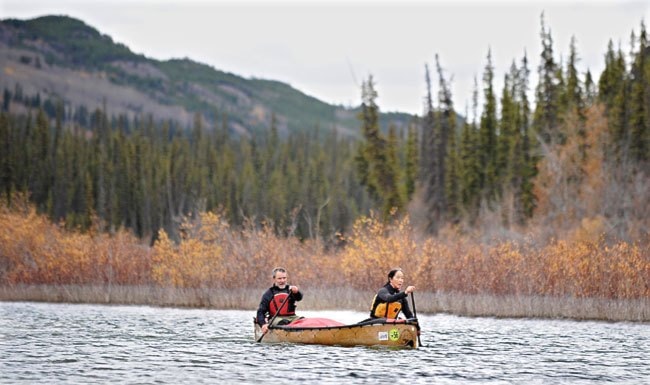By Sharron Chatterton
Standing on Teslin’s Nisutlin Bay Bridge, looking east to the Englishman Range any evening, as late at 12 p.m., a sunlit apparition can be seen, its thin limbs lifting and falling in perfect unison.
It is a 209-kilogram canoe, and will be the first Northwest Coast freighter canoe to run the Yukon River in 100 years.
It is powered by seven women, four of them first-time paddlers including the daughter of a Squamish racing paddler.
Five of them are restoring their ancestral relationship to a Tlingit canoe for the first time.
Being mothers and grandmothers, and having 17 children and more than seven jobs between them does not stop them from paddling 24 kilometres every day, in training for the Yukon River Quest.
Lisa Dewhurst, who sets the pace, regularly cycles 25 kilometres in training for the Haines bike race, and Juanita Sydney is run off her feet 9 a.m. to midnight in a busy tourist business.
Minnie Clark and Lisa Dewhurst had planned a 2008 tandem race, but chose to wait a year after recreational canoeist Mike Hodgson suggested they gather a Tlingit women’s team.
Having begun as helpful facilitator Mike Hodgson has since run the gamut from cheer-squad, boat-delivery guy, equipment and funds scrounger, and quasi-manager to shore-pacing clock-watcher when they get back late.
“I mean they are really late!” he says with a pair of emphatic eyebrows. “But hey, this is the start of something big.”
At first Hodgson went with them to stern, but has given up with obvious relief.
As the canoe slides ashore, the women’s faces tell a mixed story of tiredness, exhilaration and peace.
Carlene Hycha and Jody Sydney smoothly solo it in place and ratchet it up onto the trailer.
Some nights, Teslin Tlingit Council Chief Eric Morris drives down to help haul.
“I am in awe of what they are doing here, in awe,” he says. “These women are capturing the past for all of us. The old way, living it, for every one of us.”
Other people pause on the bridge to watch or beep approval, but the women move like a people apart, completely at ease with their tasks.
When I ask Minnie Clark, Lori Joe and Lorraine Wolfe what is happening to them, words like ‘pride’ and ‘honor’ float up.
“It is a challenge, a thing to do as women.” Each pauses, explaining her own state. “I’m relaxed, contented. I know who I am and where I want to be and just taking in the beauty, the silence,” says one while another says only, “I am strong, powerful … like the boat gives you power. It re-energizes me physically, mentally, spiritually.”
The boat in question is a showstopper.
Minnie Clarke looked at it lying on its side, its underside undergoing an elaborate tattooing, while rain drummed hard on the roof.
“A boat is being born,” she said clearly, as a thunderous series of lightning bolts hit along the lakeshore around the boat shed.
When the racket ceased, she added, carefully, “It’s going to transform itself….
“The bay is windy or the wind comes up, but every time we get in the boat, it is calm water,” she added moments later.
The artist was unmoved by the commotion.
Keith Wolfe Smarch crouched over the formerly white hull, classical Tlingit art sketches abandoned on a table, his brushes thick with red, black and blue enamels.
“Someone said, ‘Wow! Did you ever Tlingitize that canoe.’” he said. “When I was asked to do it, I was honoured they asked me. I could see it … there was an explosion of colour in my head. Tlingit culture is so visible. Halfway through, white was the enemy.”
Wolfe Smarch grinned wickedly and set to erasing the last traces of white with a still bolder flourish of black.
Lorraine Wolfe’s “big brother” had presented her with a special paddle to “capture the journey.”
“A guy told me to get a titanium paddle. He said it’s expensive, but worth it. But this paddle is worth far more to me than that.
“This paddle is Keith, his strength and knowledge in the boat with me. It is the First Nation people and their tradition, alive in this century.”
To stress their commitment, Mike Hodgson traced their training schedule over a coffee.
“We began at the school — weights, you know, walking up the hill, up the tower road and so on. Short stints, then longer and longer, then 20 miles.
“They have Laberge to get through, of course. Minnie is going over the maps. Their gear is good. I mean, these women are all bush women, though most have little or no experience of canoes. It’s been unknown to them.
“Don’t get me wrong. They shoot moose, they hunt geese, but they are on a learning curve.”
He trails off, but comes back firmly.
“I’ve made these clear: No one stops for moose. If you see any Scotsmen at Selkirk, leave them be for now.”
The Yukon River Quest begins Wednesday at 12:30 p.m. at Rotary Peace Park.
